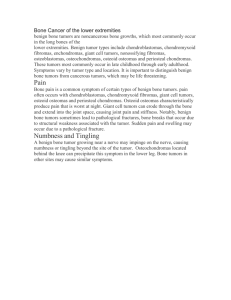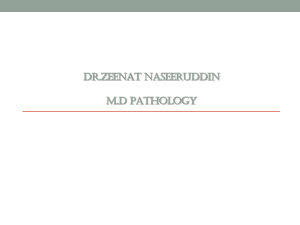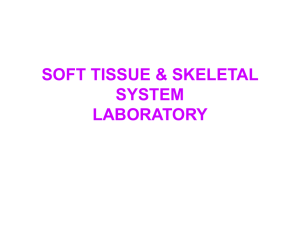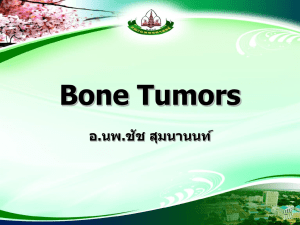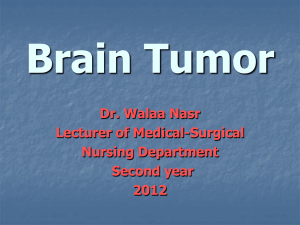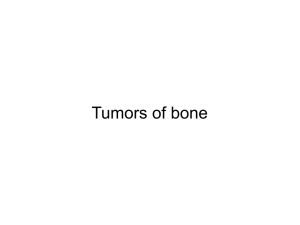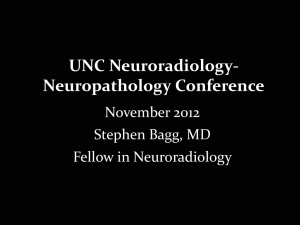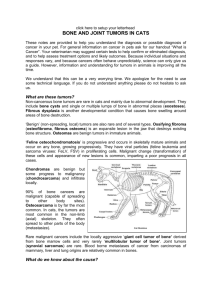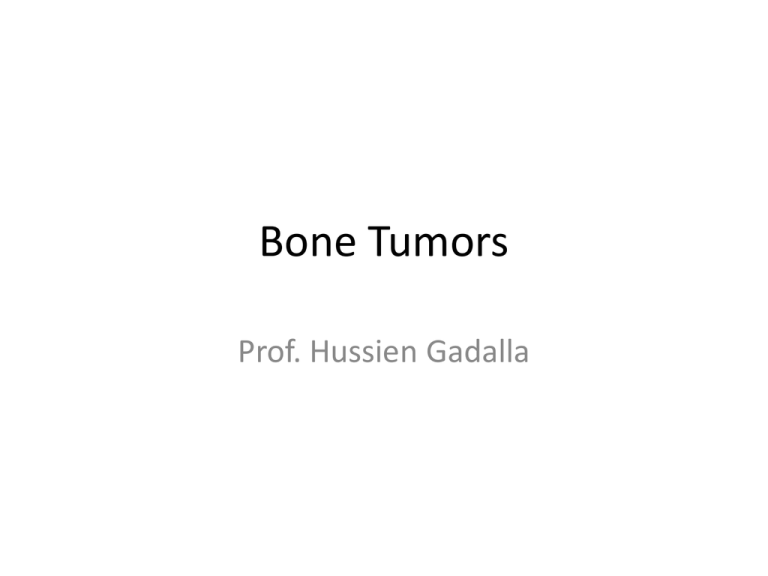
Bone Tumors
Prof. Hussien Gadalla
General considerations
• Primary bone tumors are much less than
secondary tumors.
• All age groups affected, but some tumors
occur in certain age
• Almost every bone can be affected, but some
tumors prefer certain location
• Most of the tumors give osteolytic lesion in Xray, but few are osteoblastic
Age of Tumors
• 20>…..osteoid osteoma, osteoblastoma,
osteogenic Sarcoma, Ewings.
• 20- 40……Giant cell tumors, Secondary
Osteogenic Chondrosarcoma, Lymphoma, Mets.
• 60……Mets, Myeloma, Chondrosarcoma, MFH,
Fibrosarcoma.
Site or location of Tumors
Radiographic Features of the Various
Tumors
• Benign: well circumscribed, no reaction and
sclerotic border.
• Malignant: ++++reaction, large,
permeative, destructive and moth eaten.
• Conditions/Mets: more than one bone,
symmetry.
• Benign
tumor
Malignant
tumor
Classification of primary bone tumors
A. Bone-Forming Tumors
• BENIGN
• Osteoma:
• Osteoid osteoma:
• Osteoblastoma:
• Malignant:
• Primary osteosarcoma
• Secondary osteosarcoma
Classification of primary bone tumors
B. Cartilage-Forming Tumors
BENIGN :
• Osteochondroma
• Chondroma
• MALIGNANT :
• Chondrosarcoma
• C. Miscellaneous Tumors
• Giant-cell tumor (usually benign)
• Ewing tumor (malignant)
• D. Tumor-like lesions
• Fibrous Cortical Defect (benign)
• Fibrous Dysplasia (benign)
Bone-Forming Tumors:
• Osteoma:
• Age: 40-50 ys.
• Site: on or inside the skull, paranasal sinuses and
facial bones
• Exophytic growth: Round-to-oval sessile Project
from subperiosteal or endosteal surfaces
• Usually single
• Multiple lesions are feature of Garder ssndrome.
• Usually slow- growing benign tumors
• Presentation: sinus obstruction, disfigurement and
pressure on brain.
Osteoid Osteoma &Osteoblastoma
• Both are benign bone tumors with similar
histologic features
• Grossly both tumors round to oval,
hemorrhagic and gritty
• Differ in:
Size
Sites of origin
Symptoms
Behavior
Osteoid Osteoma
Osteoblastoma
Age
10-20 years
10-20 years
Sex
2:1 males
2:1 males
Site
Femoral neck
Spine
Pain
Mod.-severe Worse
at night , Aspirin
response 90%
dull aching pain
Worse at night,
Aspirin relief,<50%
Nidus
less than 2.0 cm
2.0 -10.0 cm
Recurrence No
10%
Osteosarcoma
•
•
•
•
•
Most common primary malignant tumor of bone
Age: 10-20 years:
75% in patients below 20 years of age (primary type)
25 % old age (secondary to Paget disease)
Site: Metaphyses of long bones of limbs (60% occur around the
knee )
• M : F ratio =
1.6 : 1
Major sites
of
Osteosarcoma
Risk factors
•
•
•
•
•
•
Paget disease of bone
Ionizing radiation
Fibrous dysplasia
Chronic osteomyelitis
Bone infarcts
Mutation of TP53 gene (retionblastoma gene).
Osteosarcoma
Distal femoral osteosarcoma with prominent bone formation
extending into the soft tissues. The periosteum, which has been
lifted, has laid down a proximal triangular shell of reactive bone
known as a Codman triangle (arrow).
Clinical features
•
•
•
•
•
Presenting symptoms:
Pain
Swelling
Pathological fracture
Marked increase in the serum alkaline
phosphatase.
• Early hematogenous spread to the lungs,
liver and brain.


